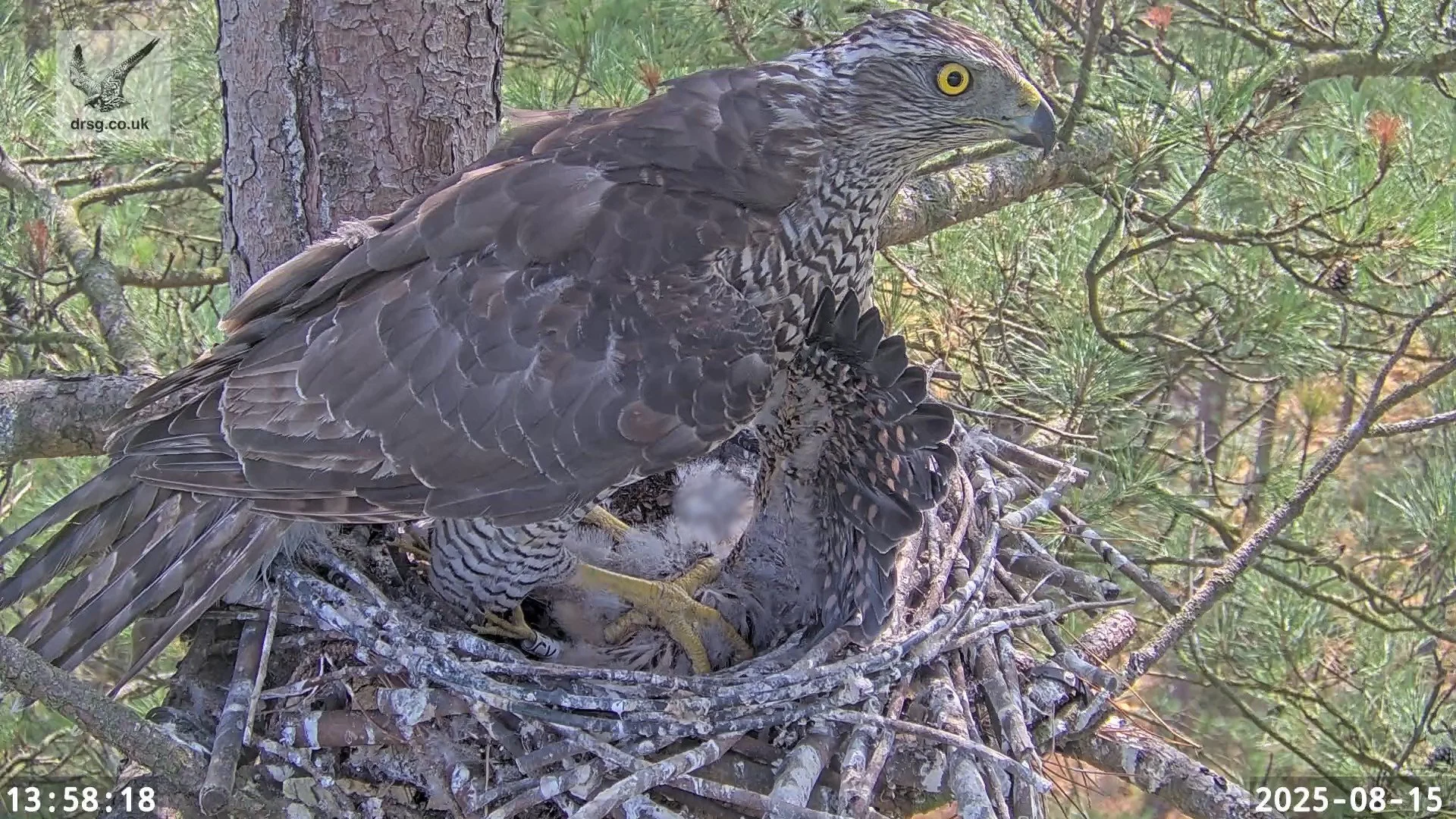A Goshawk came calling
Today on camera, two worlds collided when a Goshawk came calling.
Goshawk at the nest
Watching wildlife on live cameras is amazing, giving us a window into the world of some incredible species and showing us new behaviours. But it can also bring heartache when the animals we get so emotionally attached to don't survive. Sometimes that is from lack of food or bad weather or predation by another species.
2025 saw DRSG again share a live-stream of a wild Eurasian Hobby nest somewhere in Dorset and at first all seemed to go well. After several years on a farmland pair, the camera was moved during the winter to one of our favourite pairs within the forest/heathland complex, a landscape rich in many kinds of wildlife.
We had many weeks of happy viewing of this wild Eurasian Hobby nest.. We watched them incubate then hatch two eggs, and rear the little scrapings from balls of fluff to fine, feisty chicks near to fledging. I took a screenshot (below) of the nest as for once, the normally boisterous youngsters were quietly snoozing, and looked so peaceful. Little did they know that their time was to be so short.
Hobby chicks snoozing in the nest
Then everything changed.
The following morning both adult Hobbies could be heard calling loudly, alarming at something we couldn’t see. Shortly after a female goshawk appeared next to the nest. This goshawk was clearly not here for a social call, and was in full hunting mode. Likely hearing the noisy chicks as she flew by, or she may even have observed the adults taking food in to the nest from a great height.
Goshawk predating Hobby nest
So despite the best efforts of the adult Hobbies, the goshawk the nest and took first one chick then she came back for the second one too. The goshawk even came back once more just to be sure…
The goshawk even came back once more just to be sure…
Now you might be asking why didn’t the Hobbies fight back? Well, as a predator of incredible aerial agility, Hobbies are masterful in the sky and so in the air, the Hobby would be more than capable of launching an attack on the larger bird. However, deep in the tree canopy, they were at a disadvantage, especially against a large hungry female Goshawk.
And goshawks are big, I mean really big. See this image below from ringing a few years back, shows an immature female with a colleague's normal sized hands for comparison - just look at those feet and talons!
Female goshawk during ringing
We must remember though that, whilst it is incredibly hard to watch, Goshawks are incredible wild birds too and equally protected. And although these adult Hobby will be doing their best to protect their young, they must also take care and stay safe so they can return again next year to try again. It is likely they will return to and use the same area again next year. Approximately eight years ago, the adult female was predated from this site while on eggs: the following year, a new female returned and was successful. We will have to see in due course however, it is the Hobbies who choose where they want to nest.
Much as we are sad to lose these fabulous, feisty young Hobby chicks, this is of course nature doing what natures does. Predation events like these make hard viewing and yet they remind us that nature is a complex web of predator-prey relationships. A healthy ecosystem is full of these events and our own Hobbies have themselves predated many young birds of other species in the course of raising these chicks. And with pine martens now present in the county, there are all kinds of dangers facing a young chick in the nest.
But it makes. you think doesn't it, did you know for example that Dorset is home to such an incredible range of raptor species? Alongside the more familiar species such as Kestrel, Sparrowhawk, Buzzard and Tawny Owl, there are some less common ones like Marsh Harrier, Peregrine, Goshawk, Barn Owl and Little Owl, Osprey, Red Kite, and even Honey Buzzard. And in 2025, the first breeding success from a pair of White-tailed Eagle - how's that for a glorious guild of raptors! Truly extraordinary the wealth of wildlife here.
In the last 10+ years goshawk numbers have risen significantly in Dorset and increased goshawk numbers will make studying hobbies more difficult but we will adjust. Thanks to everyone who has helped and to Forestry England for their assistance.
We take heart in that fact that for nearly a month we've been joined by hundreds of viewers from around the world at the nest of Eurasian Hobby somewhere in southern England. Sharing the magic is part of what we love to do, giving an insight into the highs and lows of then lives of these fabulous falcons.
Heathland habitat






